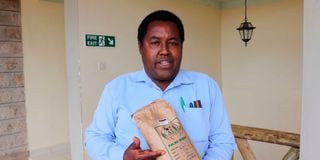Arid counties turn to new iron-rich bean varieties

Dr David Karanja, the KALRO's National Coordinator for Grains and Legumes and lead researcher for biofortified beans displays a packet of the beans variety.
What you need to know:
- Scientists led by the Kenya Agricultural and Livestock Research Organisation (KALRO) team have released new drought-tolerant bean varieties that are rich in iron and zinc.
- This makes them the most ideal for the mental health of school-going children and general health, particularly for women of reproductive age.
After years of research, scientists led by the Kenya Agricultural and Livestock Research Organisation (KALRO) team have released new drought-tolerant bean varieties that are rich in iron and zinc. This makes them the most ideal for the mental health of school-going children and general health, particularly for women of reproductive age.
And now the National Council for Nomadic Education in Kenya (NACONEK) in collaboration with other organisations has embarked on a project that will see selected schools and communities in five semi-arid counties begin to grow the new bean varieties to sustain the ongoing school feeding programmes that usually import beans.
“Kenya is a signatory of the major education protocols ensuring that no child is left behind due to socioeconomic factors that affect them and nutrition is one of the areas that improve learning outcomes,” said Murumba Chiuli, director at NACONEK – a government agency established under the Ministry of Education to coordinate and strengthen the management, administration and delivery of quality primary education to populations in the Arid and Semi-Arid Lands, pockets of poverty regions and urban informal settlements.
“We need community leaders and school heads to embrace the production of nutritious foods and own the school feeding programmes for sustainability,” he said.
So far, KALRO with support from Alliance for a Green Revolution in Africa (AGRA) has authorised 10 local seed companies to start production of the seeds for the new bean varieties to be distributed to schools and communities in the selected counties, which include Tharaka Nithi, Elgeyo Marakwet, Embu, Narok and Bomet, before the next planting season.
“We are employing a two-pronged strategy so that where soils and climatic conditions are conducive for the drought-tolerant bean production, we will support the schools to begin producing them on school compounds and feed the learners on the same, but if this is not possible, we will contract smallholders from neighbouring counties or communities to do the production and distribute the beans to the schools in need,” said Sam Okita, the programme officer for Seed Systems and Nutrition at AGRA.
As the seed companies continue with the production of the seeds, the Cereal Growers Association has identified 100 village-based advisors (VBAs) to train farmers within the target communities and schools on good agronomic practices using demo plots ahead of the planting season.
The VBAs are elite smallholder farmers from particular villages who are usually trained on different aspects of farming, including the use and access to farm inputs and good agronomical practices. They are given incentives to train local farmers using practical demonstrations.
According to Dr David Karanja, the KALRO's national coordinator for Grains and Legumes, the new iron and zinc-rich bean varieties known as nyota, angaza and faida are high-yielding. “From a packet of two kilogrammes of seed in a relatively dry area and with good agronomic practices, a farmer should expect a yield of not less than 90 kilogrammes,” he told directors of education from the five target counties who had convened in Machakos to exchange ideas on the project.
Studies have shown that frequent consumption of beans can result in health benefits such as reduced risk of heart diseases, better glycaemic control and weight management. Regular consumption of iron beans can also help improve iron stores in iron-deficient populations.
According to a study published by the Lancet Scientific Journal, micronutrient deficiencies, a synonym of hidden hunger, is a form of malnutrition that occurs due to low intake and absorption of micronutrients and vitamins such as iron, iodine, zinc and vitamin A. Such deficiencies affect sustained good health including physical and cognitive bodily functions.
Other studies have indicated that many children in Kenya and some adults have iron, zinc and vitamin A deficiencies.
As a result, more than a quarter of children, particularly those under the age of five, or two million children, have stunted growth due to a lack of essential micronutrients, according to the United Nations Children's Fund (UNICEF). This, says the UNICEF, has devastating long-term effects, including diminished mental and physical development in children.
Zinc, in particular, helps the immune system and metabolism function. It is also essential to wound healing and enhances taste and smell, while iron helps children make new red blood cells that carry oxygen from their lungs to the rest of their body.
According to Harvest Plus, iron is vital for brain development, especially in young learners; it improves the immune function in the body, provides good energy levels and puts pregnant women in good health. Its deficiency could lead to anaemia, fatigue weakness and impaired cognition.



